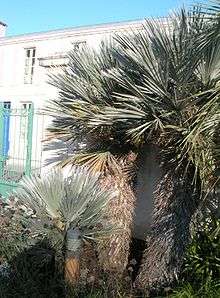Trithrinax
| Trithrinax | |
|---|---|
 | |
| Trithrinax campestris in a garden, grown as ornamental palm | |
| Scientific classification | |
| Kingdom: | Plantae |
| (unranked): | Angiosperms |
| (unranked): | Monocots |
| (unranked): | Commelinids |
| Order: | Arecales |
| Family: | Arecaceae |
| Subfamily: | Coryphoideae |
| Tribe: | Cryosophileae[1] |
| Genus: | Trithrinax[2] |
| Species | |
|
Trithrinax brasiliensis Mart. | |
Trithrinax is a genus of few flowering plants in the Arecaceae family, that belong to the Coryphoideae subfamily, a not very evolved lineage. The name is derived of ancient Greek, where tri means three, and thrinax trident. It was named as such in 1837 by Carl Friedrich Philipp von Martius a German botanist and explorer.[3]
Trithrinax species are quite spiny fan palms native to South America. They are also resistant to cold, heat, wind, drought, poor soils and other adverse environmental conditions. They germinate fast but their growth is distinctively slow.[4]
Description
Common features of any Trithrinax specimen are:
- Flowers: Inflorescences, in the order of hundreds of units. Three sepals, three petals, six stamens and three carpels.
- Stem: Dead foliage is kept as a thick and spiny coat around it.
- Leaves: Fan shaped, composed of strong resistant fibers.
- Shoots: Red coloured.
Taxonomy
In the first edition of Genera Palmarum (1987), Natalie Uhl and John Dransfield placed the genus Trithrinax in the subfamily Coryphoideae, the tribe Corypheae and the subtribe Thrinacinae[5] Subsequent phylogenetic analysis showed that the Old World and New World members of the Thrinacinae are not closely related. As a consequence of this, Trithrinax and related genera have been placed in their own tribe, Cryosophileae.[1]
Habitat
Trithrinax species are spread along vast subtropical zones of South America: Bolivia, Brazil, Paraguay, Uruguay, Argentina. They prefer dry, open or forest clearing, environments, with moderate to cold winters.[6]
Usage
Leaf fibers are used as raw material for textiles, rustic clothing, and handicrafts. Oil can also be extracted from seeds. Fruits are sometimes used locally, fermented, to produce alcoholic beverages.[6]
References
- 1 2 Dransfield, John; Natalie W. Uhl; Conny B. Asmussen; William J. Baker; Madeline M. Harley; Carl E. Lewis (2005). "A New Phylogenetic Classification of the Palm Family, Arecaceae". Kew Bulletin. 60 (4): 559–69.
- ↑ Martius, Historia Naturalis Palmarum 2:149. 1837. Type:T. brasiliensis
- ↑ Moore, H. E., Jr. 1963. An annotated checklist of cultivated palms.
- ↑ Riffle, Robert L. and Craft, Paul (2003) An Encyclopedia of Cultivated Palms. Portland: Timber Press. ISBN 0-88192-558-6 / ISBN 978-0-88192-558-6
- ↑ Uhl, Natalie E.; John Dransfield (1987). Genera Palmarum: a classification of palms based on the work of Harold E. Moore Jr. Lawrence, Kansas: The L. H. Bailey Hortorium and the International Palm Society.
- 1 2 Jones, D. L. 1994. Palms throughout the world.